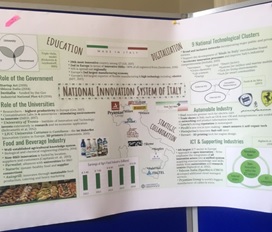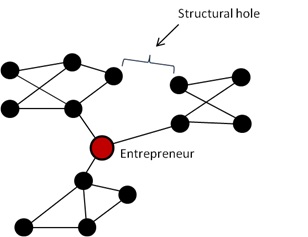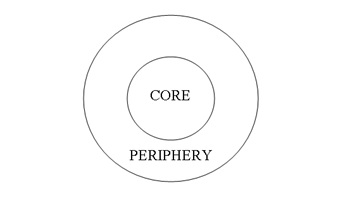Poster Making Homework Help

Hire top Rated Poster Making Homework Help Professionals at Urgenthomework
1. A short description of the content of the Poster, a justification for the way you organized it visually
This poster is created on the subject matter, innovation of the United States of America. Points included in the poster are a brief introduction regarding the share of U.S international GDP, position of the government, telecommunications status in this state, information regarding Aerospace, finance, and banking details, the current condition of educational development, R&D Capacity and infrastructures, IT, environmental change and impact along with a conclusion. Concisely, this poster is portraying information regarding all the important sectors and their current status within U.S.A. All the graphs and information attached in this poster about different sectors are necessary and important for understanding the influence of these sectors’ operations in the global market.
This poster is reflecting about all the necessary information. All the information highlighted in this poster is exhibiting important information regarding this country. As the heading suggests innovation of U.S.A, I have mentioned the governmental information regarding policies and regulations at the beginning as these policies are connected with all the other sectors mentioned in this poster. On the other hand, the education point is also placed in line with the introduction and marked in red colour to point out the fact that, this factor is also important within this country. Also, other points and graphs attached in this poster are placed in this way to clear current situations of different sectors as described in a more effective way.
2. A critical review of one other poster.
The poster you identify for review should be clearly identified with a picture; its strengths and weaknesses discussed in a detailed way and feasible strategies for improvement should be recommended.

Figure 1: Italy’s Poster
The other poster named as National innovation system of Italy has been delivered less systematically than the previous poster. The strengths and weaknesses of this poster along with feasible strategies for development would be suggested in this section.
Strengths of Poster
The above poster two kinds of frameworks including important points and illustration of the points as well as governmental regulations and policies, role of universities, food and beverage sector, 9 National Technological Clusters, automotive sector and ICT and Supporting sector information. All the graphs and charts involved in this poster are relevant and eye-catching. The format chosen for making up this poster is also justified as all the information is illustrated properly.
Weaknesses of the Poster
The concepts and ideas illustrated in the above poster could have been arranged and communicated in a more structured way. The group involved in making this poster is lacking adequate skills in arranging all the necessary information in a systematic line like the other poster. On the other hand, information that is provided in the above poster could be more explanatory to develop an understanding regarding individual points. If the poster has been made according to the above-mentioned points, then audiences could develop a better knowledge National Innovation System of Italy.
Feasible strategies for development in poster making homework help
Choosing a meeting session
While preparing this poster, the abstract should be submitted to a suitable session by anticipating the target audiences that the group or individual wants to attend the poster (Zarnetske and Zarnetske, 2015).
Be logical and straight to the point of creating the heading
The title of a poster should highlight the main points of a poster. Presentation of the title should be straightforward to the main topics and be selected carefully.
Carefully formulating the poster storyline
Before commencing with the poster design and construction, one should calculate and decide upon the main storyline along with the “give and receive” scope in mind. For instance, include relevant data and findings, which should be discussed in the presentation.
Applying proper formatting
The formatting and layout of the poster content are very much significant. The group or individual making a poster should obey the given guidelines for the style and inclusion of the figures and texts. Important points that need to be followed are the amount of the text, figure resolution, color of the poster, font size, and others (Zarnetske and Zarnetske, 2015).
3. A complete analysis of the dataset provided to you including at least the following network metrics/analysis
The given database provided in the picture would be analyzed through centrality measurement, Density, and any other network-level measures, Subgroup methods, Structural holes/brokerage Core-Periphery, and theories.
3.1 Centrality
According to Scott (2017), in graph theory and network analysis, pointers of centrality classify the most significant verticals within a graph. In order to qualify the significance of various nodes included in networks, centrality measurement or indices were introduced. There are five main types of centrality indices that are available; includes “Degree centrality, Closeness centrality, Betweenness centrality, Eigenvector centrality, and PageRank centrality” (Boldi and Vigna, 2014). Analysis of the main poster attached in this study has been done by using centrality as a network metric. The main poster portrays the topic, “Innovation of United States of America”. The central idea of this poster that has been indicated is Innovation. All other points such as Government, Telecommunications, Aerospace, Banking and Finance, Education, R&D Capacity and Infrastructures, Environmental Impact and IT are the sub-points that have a connection with the main theme. The centrality measurement of the Poster is described below,
According to the poster, the government is trying to invent and regulate some new acts to bring innovation regarding jobs and working structure in the U.S.A. Act of 2011 and US STI policy are made to induce job opportunities and developing financial competitiveness along with increasing inventors’ capacities to protect intellectual properties. On the other hand, telecommunications services are also trying to launch advanced programs to reduce the digital divide. Just like these two points, all other points are linked with the central theme of this poster.
3.2 Structural holes/brokerage
The ‘structural hole’ is a theory mainly used in ‘social network research’, developed by Roland Stuart Burt. This concept refers to the gap involved between two points or individuals who have corresponding sources of information (Tan et al., 2015). On the other hand, a Brokerage system would be helpful in connecting the gaps identified in two points. The given poster has structural holes in terms of information provided in the education-efficiency level. Though the spending in this industry is huge, it is noted that there has been a decline in the education-efficiency category, productivity, manufacturing, and value-added services. These identified gaps could be reduced with innovative technological and managerial support as a brokerage in the network system.

Figure 2: The structural hole
(Source: Adams et al., 2018 )
3.3 Density and any other network-level measures
Density is a measurement that is connected to the “compactness” of a matter within a substance. Density is measured through this equation (Density = mass/volume). The “number density” of objects could be applied here to understand the number of sub-points and its importance within a unit of volume (Allen and Tildesley, 2017). In this poster, all the sub-points (ten sub-points) bear significance to unfold the urgency and importance of innovation in the entire service sector of U.S.A. Therefore, the density measures of these sub points (Government, Telecommunications, Aerospace, Banking and Finance, Education, R&D Capacity and Infrastructures, Environmental Impact and IT) are connected to the main concept of innovation. The density measurement of all these sub-points is important for developing an understanding of the quantity of production form all these service sectors within U.S.A.
3.4 Core-Periphery
This theory is a spatial metaphor that unfolds and efforts to describe the structural communication among the developed ‘centre’ and a less advanced ‘periphery’ within a specific nation or as used to the connection between emerging and capitalist societies (Rombach et al., 2017). The significance of this model could be understood in identifying what are the advanced ‘center’ (Education, Telecommunication, Government, R&D Capacity and Infrastructure, and Aerospace) and a less advanced ‘periphery’ (Banking and Finance and Environmental Impact) of country’s service sector. This means the poster is showing the necessity of innovation in relation to some points against the strong service sectors within U.S.A. This analysis is stating the fact that some sub-sectors include in the given poster are more progressive than other sectors.

Figure 3: The Core-Periphery model
(Source: Rombach et al., 2017)
3.5 Subgroups
One of the main concerns related to social network evaluation is the reorganization of cohesive subgroups of players in some specific networks. This study tries to unfold a subset of actors among whom there are comparatively direct, usual, strong, intense ties. On the other hand, a cohesion region is a space within which there are subgroups. In this poster, there are various subgroups presented which have a connection with bringing innovative operations in the service sector operations of U.S.A.
4. Your overall view on the potential future strategy of the firm,
including recommendations for change and/or potential for new opportunities
Wells Fargo & Company is a multinational American banking and financial services holding organization that is headquartered in San Francisco. This organization is the 2nd largest bank across the globe according to its marketplace capitalization, and it is ranked as the 3rd largest bank in the U.S.A according to its organizational assets. As per the financial record documented in 2017, the net income of this company is around US$27.337 billion (Wellsfargo.com, 2018).
The given picture on innovation in America has a sub-point named banking and finance. This point has highlighted some major points that are stating the current position of this sector in their domestic country as well as internationally. According to this sub-point, this industry offers the effective transfer of saving towards investment projects. On the other hand, this sector is prone to develop mobile payment services, inventing solutions to make sure effective electronic payments are made to the right payee and others. The future strategy of Wells Fargo & Company should be to implement all these innovative services and mechanisms in their investment and finance-related services along with ramps up marketing in the push to achieve customer trust.
As per this business strategy, this organization needs to appoint an efficient investigation team that will be investigating various effective solutions to ensure that electronic payments are done in a systematic way. On the other hand, careful investments should be made by the finance department for multiple authorizations for all business online channels to support and increase the online banking services of this company.
Bibliography for Poster Making Homework Help from Urgenthomework
Adams, M., Makramalla, M. and Miron, W. (2018). Down the Rabbit Hole: How Structural Holes in Entrepreneurs' Social Networks Impact Early Venture Growth. [online] Timreview.ca. Available at: http://timreview.ca/article/828 [Accessed 26 Mar. 2018].
Allen, M.P. and Tildesley, D.J., 2017. Computer simulation of liquids. Oxford university press.
Boldi, P. and Vigna, S., 2014. Axioms for centrality. Internet Mathematics, 10(3-4), pp.222-262.
Gilsing, V., Nooteboom, B., Vanhaverbeke, W., Duysters, G. and van den Oord, A. (2018). Network embeddedness and the exploration of novel technologies: Technological distance, betweenness centrality, and density.
Rombach, P., Porter, M.A., Fowler, J.H. and Mucha, P.J., 2017. Core-periphery structure in networks (revisited). SIAM Review, 59(3), pp.619-646.
Scott, J., 2017. Social network analysis. Sage.
Tan, J., Zhang, H. and Wang, L., 2015. Network Closure or Structural Hole? The Conditioning Effects of Network‐Level Social Capital on Innovation Performance. Entrepreneurship Theory and Practice, 39(5), pp.1189-1212.
Wellsfargo.com. (2018). About Wells Fargo. [online] Available at: https://www.wellsfargo.com/about/ [Accessed 26 Mar. 2018].
Zarnetske, J.P. and Zarnetske, P.L., 2015. Strategies for creating a conspicuous, effective, and memorable poster presentation. GSA Today, 25(5), pp.66-68.

